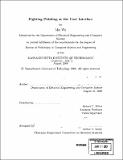| dc.contributor.advisor | Robert C. Miller. | en_US |
| dc.contributor.author | Wu, Min, 1976- | en_US |
| dc.contributor.other | Massachusetts Institute of Technology. Dept. of Electrical Engineering and Computer Science. | en_US |
| dc.date.accessioned | 2008-01-10T17:22:32Z | |
| dc.date.available | 2008-01-10T17:22:32Z | |
| dc.date.copyright | 2006 | en_US |
| dc.date.issued | 2006 | en_US |
| dc.identifier.uri | http://dspace.mit.edu/handle/1721.1/38314 | en_US |
| dc.identifier.uri | http://hdl.handle.net/1721.1/38314 | |
| dc.description | Thesis (Ph. D.)--Massachusetts Institute of Technology, Dept. of Electrical Engineering and Computer Science, 2006. | en_US |
| dc.description | Includes bibliographical references (p. 193-199). | en_US |
| dc.description.abstract | The problem that this thesis concentrates on is phishing attacks. Phishing attacks use email messages and web sites designed to look as if they come from a known and legitimate organization, in order to deceive users into submitting their personal, financial, or computer account information online at those fake web sites. Phishing is a semantic attack. The fundamental problem of phishing is that when a user submits sensitive information online under an attack, his mental model about this submission is different from the system model that actually performs this submission. Specifically, the system sends the data to a different web site from the one where the user intends to submit the data. The fundamental solution to phishing is to bridge the semantic gap between the user's mental model and the system model. The user interface is where human users interact with the computer system. It is where a user's intention transforms into a system operation. It is where the semantic gap happens under phishing attacks. And therefore, it is where the phishing should be solved. There are two major approaches to bridge the semantic gap at the user interface. One approach is to reflect the system model to the user. | en_US |
| dc.description.abstract | (cont.) Anti-phishing toolbars and the browser's security indicators take this approach. User studies in this thesis show that this approach is not effective at preventing phishing. Users are required to constantly pay attention to the toolbar and are expected to have the expertise to always correctly interpret the toolbar message. Normal users meet neither of these requirements. The other approach is to let users tell the system their intentions when they are submitting data online. The system can then check if the actual submission meets the user's intention or not. If there is a semantic gap, the system can effectively warn the user about this discrepancy and provide a safe path to the user's intended site. Web Wallet, designed and implemented as a new anti-phishing solution, takes this a~pproach. It is a dedicated browser sidebar for users to submit their sensitive information online. User studies in this thesis shows that Web Wallet is not only an effective and promising anti-phishing solution but also a usable personal information manager. | en_US |
| dc.description.statementofresponsibility | by Min Wu. | en_US |
| dc.format.extent | 199 p. | en_US |
| dc.language.iso | eng | en_US |
| dc.publisher | Massachusetts Institute of Technology | en_US |
| dc.rights | M.I.T. theses are protected by copyright. They may be viewed from this source for any purpose, but reproduction or distribution in any format is prohibited without written permission. See provided URL for inquiries about permission. | en_US |
| dc.rights.uri | http://dspace.mit.edu/handle/1721.1/38314 | en_US |
| dc.rights.uri | http://dspace.mit.edu/handle/1721.1/7582 | |
| dc.subject | Electrical Engineering and Computer Science. | en_US |
| dc.title | Fighting phishing at the user interface | en_US |
| dc.type | Thesis | en_US |
| dc.description.degree | Ph.D. | en_US |
| dc.contributor.department | Massachusetts Institute of Technology. Department of Electrical Engineering and Computer Science | |
| dc.identifier.oclc | 154235030 | en_US |
